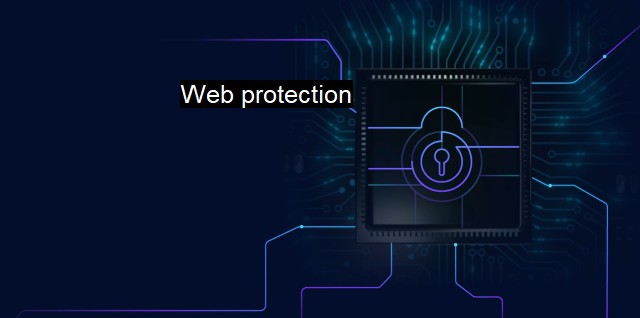What is Web protection?
The Importance of Web Protection in Today's Cybersecurity Landscape: Staying Ahead of Malicious Threats in the Digital Age
Web protection is a term that describes various strategies, protocols, and tools designed to secure internet services, web applications, and online transactions from cyber threats, often used interchangeably with terms like internet security or web security. It often revolves around establishing defenses and measures to prevent unauthorized access, use, disclosure, or alteration of the information that travels over the internet. Web protection thus plays an integral role in any cybersecurity strategy as it seeks to safeguard internet users and ideally protect every interaction an individual or an organization has with the Internet universe.One of the crucial aspects of web protection is antivirus software. This software is specifically designed to detect, prevent, and erase malware, including computer viruses, Trojans, computer worms, ransomware, spyware, adware, and other malicious programs. It operates by scanning your system files, determining whether there are any unidentified or suspicious files, and then eliminating them. Most contemporary antivirus programs have the ability to update their databases with the newest information about malware and threats, consequently enhancing their detection capacities and performance.
Web protection also encompasses the use of firewalls, a network security system acting as the first line of defense, monitoring and controlling incoming and outgoing network traffic. A firewall establishes a barrier between a trusted internal system and untrusted external systems to protect against unauthorized access. They can be personalized to the user’s specific requirements to ensure a safer online experience.
Website encryption is another facet of web protection. It involves converting data into a code to avoid unauthorized access. Websites make use of Secure Sockets Layer (SSL) or Transport Layer Security (TLS) to maintain data integrity and security during transmission. This encryption process protects the communication line ensuring only the sender and intended receiver can view the transmitted data. It is an instrumental strategy in safeguarding sensitive information like credit card details, login information, or other personally identifiable information.
Web protection strategies additionally incorporate safe browsing tools. Most contemporary browsers have features that warn users when they attempt to navigate to dangerous sites or predictively block potentially harmful websites. privacy-oriented browsers have been developed; browsers like Tor and DuckDuckGo which emphasize user privacy and don't compile or sell your data.
Web protection is far from limited to technologically driven solutions. Education around cybersecurity threats for organizational personnel or individuals helps ensure people can identify common threats such as phishing scams or deceptive websites. Users need to be continually informed about evolving online threats and the best ways to counter them. Awareness and education are powerful preventative tools in the realm of web protection and cybersecurity at large.
Timely and routine patching and updates of applications, including antivirus software and operating systems, helps enhance web protection. Keeping systems current factors highly in maintaining optimum defense against the latest threats, reinforcing the armory with the latest and most appropriate countermeasures.
Data backup and recovery tools are also integral within the context of web protection. In the event of a system or data breach, having a backup in place may be the only solution to restoring normal operations. Ensuring automated and regular backups is just as vital as having fail-safe recovery systems and options in place.
Web protection is a multi-faceted and complex strategy that spans antivirus programs, firewalls, encryption, safe browsing tools, user education, secure code writing practices, routine patching and backups. In the increasingly digitized and interconnected world, cybersecurity threats will continue to be pervasive. Hence, robust and proactive web protection strategies are tantamount in ensuring safe, secure, and uninterrupted web experiences for individuals and organizations. Technologies, awareness, and strategy lay at the heart of web protection, all centered on outsmarting and outpacing the evolving and multi-pronged cybersecurity threats.

Web protection FAQs
What is web protection?
Web protection is a cybersecurity measure designed to safeguard your computer and web-enabled devices from online threats. This includes malware, phishing attacks, and other malicious programs that hackers use to steal sensitive information.What are the different types of web protection?
There are several types of web protection, including antivirus software, firewalls, spam filters, and content filters. Antivirus software scans your computer for malicious code, while firewalls block unauthorized access to your network. Spam filters prevent unwanted emails, and content filters block access to websites with potentially harmful content.How do I choose the right web protection software for my needs?
When choosing web protection software, consider your specific needs and budget. Look for software that offers comprehensive protection against various online threats, has regular updates, and provides customer support. You should also ensure that the software is compatible with your operating system and web-enabled devices.Can web protection software guarantee complete online safety?
Unfortunately, no web protection software can guarantee complete online safety since new online threats emerge regularly, and hackers are continually developing new methods to bypass security measures. However, web protection software can significantly reduce the risk of online threats and make it more challenging for hackers to gain access to your computer or network.| | A | | | B | | | C | | | D | | | E | | | F | | | G | | | H | | | I | | | J | | | K | | | L | | | M | |
| | N | | | O | | | P | | | Q | | | R | | | S | | | T | | | U | | | V | | | W | | | X | | | Y | | | Z | |
| | 1 | | | 2 | | | 3 | | | 4 | | | 7 | | | 8 | | |||||||